As the market has changed over the years, the AR-15 and the AR-10 have become the type of rifles you can make your own and still expect excellent results, no matter what you build it for. Recently however as new calibers and cartridges come on the market, compatible with the AR platform.
The question now becomes is the platform capable of holding the tightest tolerances and delivering down range for sub minute of angle accuracy, the likes of which has only been expected out of bolt actions, prior to this. After all, you can get a brand new conversion upper receiver in an incredibly accurate cartridge like the 6.5 Creedmoor relatively inexpensively and that cartridge is certainly capable of shooting sub minute of angle easily.
Already proven exceptionally competent in the hunting space, both the AR-15 which prioritizes a shorter cartridge, and the AR-10 which adds the ability to access longer cartridges have performed admirably. But dispatching an Elk at 400 yards is a lot different than trying to shoot a half minute of angle at 600.
The Kill Zone on an elk or a deer or another large game animal is probably as much as 9 to 13 inches (not to mention there are multiple areas to aim for). The same shot to hold a minute of angle needs to be under 6 inches at 600 yd. Or, for 1/2 minute of angle it’s 3 inches at 600 yards, and a quarter minute of angle is an inch and a half at the same distance.
Let’s be clear: anyone expecting a quarter minute of angle out of any gun is going to spend thousands of dollars, and it’s likely there is no better platform than a bolt action for such an endeavor. Anyone arguing against that, isn’t accounting for reality.
When you need that type of accuracy you aren’t taking shots quickly in succession and likely do not need semi-automatic actions. There are also inherent benefits to using a bolt action for shots taken at that range, including ergonomics, optics mounting, and ultimately weight and tolerances, etc. Not only that, but the platform lends itself well to monolithic, precision builds with fewer components and less overall optimization to achieve excellent long range results.
What’s a reasonable expectation from a “long range precision rifle”?
Let’s start by dispelling some myths about long range precision shooting.
It’s not inexpensive.
To shoot 1/4 minute of angle or the equivalent in mils, is ridiculously hard to achieve. Historically, long range precision shooting has been in the realm of people who could afford it. And there is a reason: it costs a lot of time and a lot of money to dial-in loads, guns, ranges, and conditions each time you shoot. Long range precision optics are expensive; modifying already expensive guns is expensive.

Forget about just the economic parts of the equation, it’s difficult to find hardware and create loads that consistently outperform all competition on the market. A long-range precision rifle where it was once comfortable sub minute of angle, is now in the realm of sub 1/2 minute of angle.
To even meet that threshold is exceptionally difficult. Most shooters don’t have the skillset to consistently shoot at 1/2 minute of angle – taking nothing away from the obviously well-read and skilled readers of this website.
This isn’t a lecture, however there might be some interesting concepts or ‘food for thought’ within the context. One could make the argument, and probably should make the argument that anything sub 1 minute of angle consistently out at long distances, is where long range precision rifle shooting should be positioned.
One could also make the argument that sub 1/2 minute of angle at long ranges is the goal to shoot for.
Because of the proliferation of long-range precision shooting forums and other online and communication advances, it almost seems that the long range precision shooting story has become similar to the “fish that got away” story. Not everyone is always shooting a quarter minute of angle at 500 yards. That’s simply unrealistic.
Let’s take for instance the case for a caliber that many people are shooting at long range distances and pushing the limits of precision. Let’s say you’re shooting a .338 Lapua Magnum. Certainly, this cartridge has the range and the terminal ballistics to take out just about any target at more than a thousand yards, and even more than 1,500 yards in many situations.
The problem is that the very diameter of the caliber means that two shots placed edge-to-edge next to each other, by anyone’s determination a fantastic 2-shot grouping, would still equal more than .700 of an inch.
That’s a 3/4 minute angle group at 100 yards. To say that a vast majority of shooters are consistently shooting 2 Shot or 3 shot groups at under .700 an inch (equivalent) at anything more than 150-250 yards is a bit of a stretch.

For full transparency, it’s not all that difficult to shoot sub 1MOA at 100 yards. Maybe not even at 300 yards, but it gets harder the further you go out. Ballistics do factor into the equation.
Of course, you can achieve this with smaller calibers, or over shorter ranges. The .338 Lapua will easily shoot sub 1 minute of angle up to 1,000 yards in the right platform. It’s built to do that. Even the cheapest examples of bolt action rifles in that caliber tend to be quite accurate.
If you were to do the same thing with a 6.5 Creedmoor at 600 or 700 or 800 yards, you can expect similar results. It absolutely can be achieved. But to think that it’s being achieved all the time, every time at those ranges, regardless of what the conditions are, seems a bit unrealistic.
Similarly, publications like blog posts or YouTube videos may also be a bit irresponsible by showing the best three shot group out of 150 shots, that complement the authors capabilities.
Just because a gun is capable of shooting sub half minute of angle doesn’t mean that it’s happening every single time.
So, let’s just set the record straight and make a realistic comparison to what is actually happening when you take a gun out to the range for long range shooting, at least for the purposes of this article. Furthermore, for the following discussion, it would be irresponsible not to talk about the truths of building a long-range precision rifle on the AR platform. Before we get into the specifics of such an endeavor, let’s just be transparent with the facts:
- It’s going to be incredibly expensive
- Your AR is likely, going to be front-heavy
- Forget that it’s just going to be front-heavy, it’s going to be heavier all-over than a bolt-action generally, because you must add a lot of components and a lot of barrel weight; you may even need to balance the rear end of the firearm as well
- It’s going to be hard to source the right parts during some parts of the year
- You’re going to need to know how to build an AR well
- Over time, the AR platform is not going to hold up as well (from a tolerance perspective) as a more robust firearm will
- Tolerances are not what an AR is built for, and while you can modify one to achieve excellent tolerances, they are never going to be on the level of a bolt-action firearm – at least not from a precision hardware perspective
- Optimizing loads and barrels become more important – unfortunately for the AR platform, many of the best optimization combinations aren’t available
Having said all that, it is not impossible to build an AR-15 to an exacting standard and have it be in the same realm of competition as a bolt-action firearm for many long-range precision shooting needs.
Simply put it will be an undertaking, however.
Historically, how have long-range Precision rifles been judged and implemented by the shooter?
If you’re Talking about benchrest that’s one thing, but for general-purpose long range shooting, it’s usually been the undertaking of a highly modified bolt action rifle if you needed to get past 750 yards.
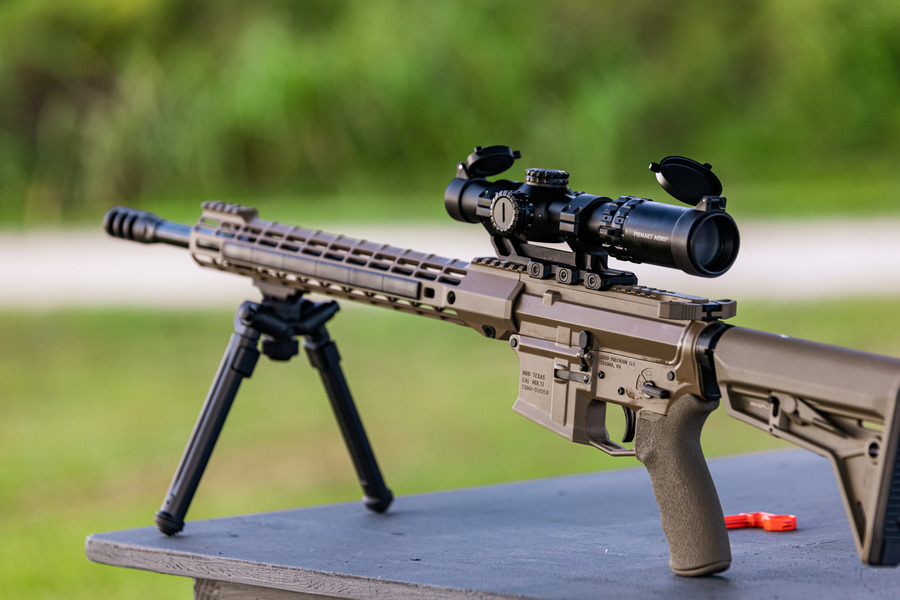
Fortunately, for shooters nowadays, factories have implemented automatic procedures, high tolerance machining and high-end, optimized engineering processes that make reaching precision goals from a hardware perspective much more available to those with less budget relative to historical shooters.
This is especially true when it comes to the AR-15 or the AR-10. Factories producing these platforms generally have invested heavily in high end 5 axis machine tool technologies or other substantially similar technologies that make precision on the hardware and manufacturing side very consistent and push high-tolerance machining into the mainstream.
When you look through the historical lens however, almost everything beyond 400 yards has been done with bolt actions from hunting to competition previous to now. Of course, you’d have a few modified M1A’s, or similar, but the AR was never truly competitive until the last decade or so.
The word “competitive” as mentioned above, may not have a one-to-one correlation in many precision shooter’s minds, however. Benchrest shooters have been achieving sub half minute of angle accuracy for decades. One couldn’t reasonably obtain such accuracy out of the AR platform until about 10 years ago. Even then, the cartridges associated with the most mainstream long range precision components weren’t pushing the envelope for sub half minute of angle.
With the huge increase in mainstream shooters’ interest in shooting competitions on a regular basis, the AR-15 has had to evolve, and the AR-10, specifically, has found a nice spot in the up to 750 yards arena.
What’s possible with an AR-15 from a long-range perspective?
If you’re looking at the AR-15 for a possible sub half minute of angle shooting firearm, you’re likely not going to get past 600 yards very easily. A combination of factors limits this. Some of those factors are listed below, though this list is not comprehensive.
- Smaller cartridges lack the necessary bulk of powder in order to reach ballistic needs past this point (600 yd) and bullet drops create difficulty cementing sub half minute of angle past that point
- Even if you have a cartridge That could reach out past the 600 yard range, the optimal barrel length would likely not make sense for an AR-15
- Compensation for wind or bullet drop can be difficult for smaller projectiles
- The gun hasn’t been built to do this specific task, generally
- The cost to make an AR-15 reach out past those distances with the type of precision groups that a long-range precision shooter is desiring is high
Notwithstanding, if choosing the right caliber to build an AR-15 on, you can achieve results past 600 yards, but it won’t be super consistent without heavy attention to detail, constant tweaking, and it will be expensive.
For instance, you might look at some of the newer releases in the caliber realm for the AR-15, including the 6.5 Grendel, the .300 Hamr, and the .224 Valkyrie.
If you were to optimize the barrel twist, barrel length and the connection between the two receivers, and the barrel fitment, it’s likely you could find a gun that would shoot 400 to 600 yards with relative consistency and be approaching half minute of angle.
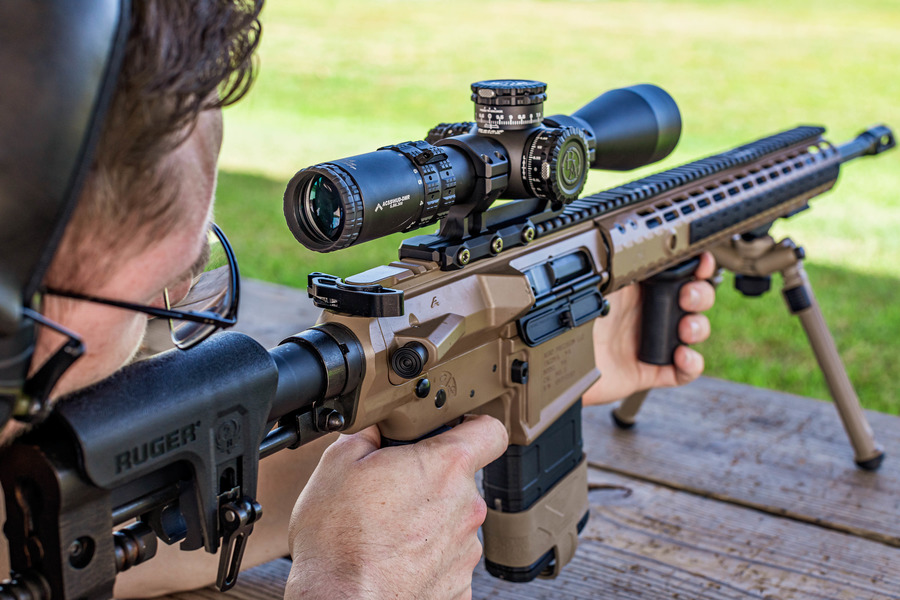
Looking much past 600 yards, you’re not going to find any caliber or set up that is going to consistently drive tacks at sub half minute of angle.
Even if you do have a gun capable of doing that, you may have spent way too much to build it to do so on the AR-15 platform. Subsequently, you will also have the issue with the fact that the aluminum chassis of the AR-15 will eventually wear, and tolerances will begin to expose the inherent weaknesses in building a long-range precision rifle on a two-part platform.
The key here is the desire to do it on the platform, and the goal of not overusing the gun without appropriately compensating for the extra volume of rounds.
Given all that information, it would be possible to build a gun that would not have a huge volume of ammunition shot through it, that is capable of long-range precision shooting. Most long-range precision shooters do not shoot huge volumes unless they are practicing for competition year-round. So, this may be a viable option for some.
What’s possible with an AR-10 from a long-range perspective?
The same may not be true for the AR-10 or other .308 Winchester based AR platforms. When you have the ability to move up in cartridge length, you have the ability to add volume of powder, pressure in the chamber, and support for a larger and longer, heavier barrel. Also, the AR-10 and substantially similar platforms that are clones of that rifle are geared towards more accuracy potential out of the box.
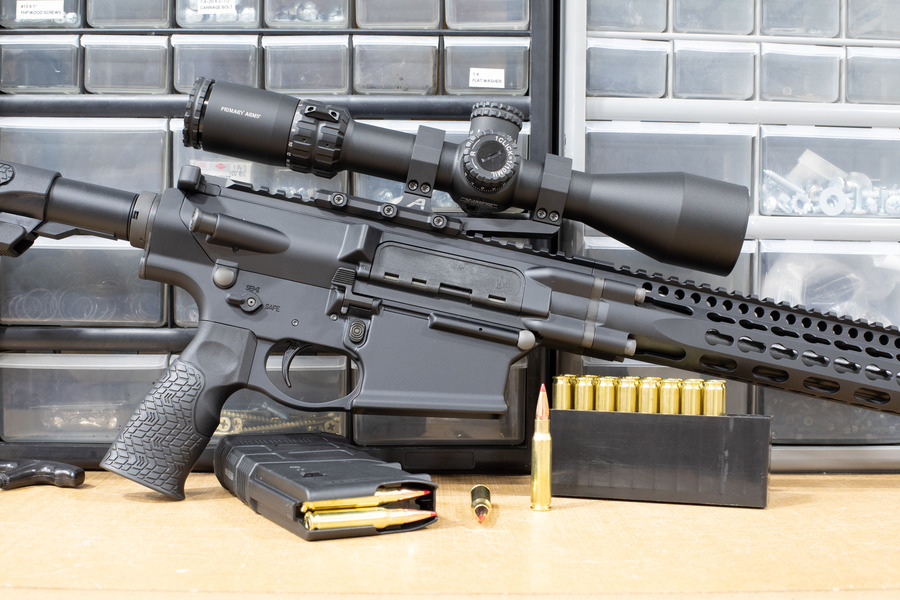
With the 6.5 Creedmoor having come online in the marketplace and having proven itself as an accurate and reliable long-term option, the makers of AR-10 components, full rifles, and particularly barrels which are chambered with extreme accuracy, it is entirely possible to compete at the half minute of angle Mark out to nearly 850 yards.
Beyond that point you need to do a lot of things to a gun to be able to expect absolute consistency that can keep up with something like the monolithic build style of a bolt action rifle. There are diminishing returns past that point. Can it be done? Yes. Is it cheap? No. Is it easy to source all the parts, put them together and maintain them at high tolerances over the long term? Not as easy as it is with a bolt-action.
The .308 Winchester cartridge, similarly, can be made to shoot quite accurately at up to 750 yd. Beyond that point specialty ammunition and high-end barrel dynamics will need to be implemented to ensure consistency.
As the AR-15’s popularity continues to grow, and the AR-10 proves itself as a legitimate long-range contender, platforms like the AR-15 and the AR-10 specifically, are going to be able to accept a wider range of long-range precision cartridges eventually.
This may manifest only in a one-off format, but the market will make it available if there is enough desire from those who are buying.
You can already see one-off versions of the 300 Winchester Magnum and other rifle cartridges that would normally be in the realm of a long action bolt action rifle.
Can you even be competitive with an AR platform?
To be competitive one doesn’t need the best rifle in the world. However, what you lack in Long Range Precision from a hardware perspective, you must make up for from a “skill-set” perspective. The better the shooter the more capable they are of hitting a long-range precision target properly and consistently.
In most competitions currently across the shooting landscape, you don’t need to shoot sub half minute of angle generally. In fact, there are many competitors that are winning or coming close to winning major competitions that aren’t even shooting guns capable of hitting half minute of angle over the long-term consistently.
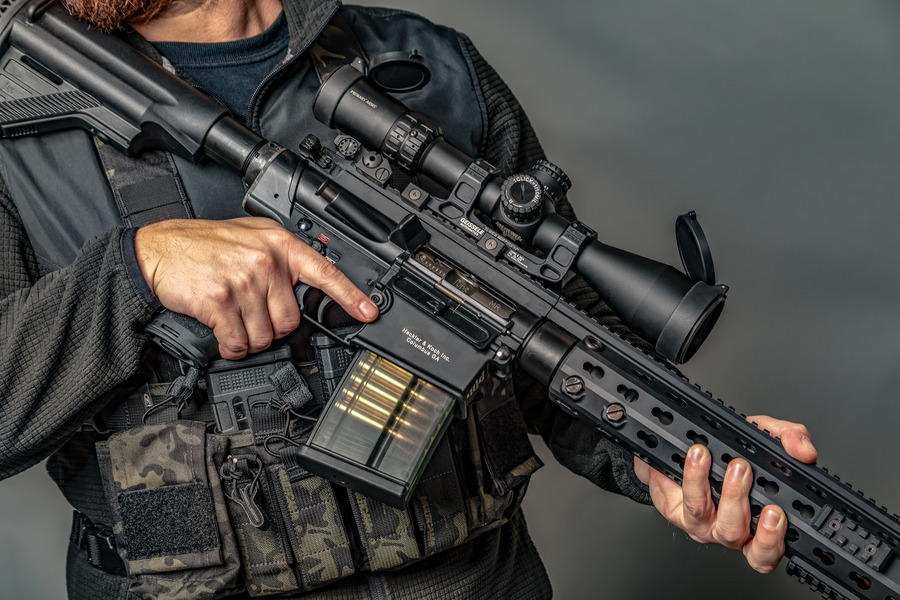
This is because most of the competitions involve movement, or there are large budgets and very astute shooters using these firearms that aren’t otherwise built on bolt-action platforms.
Leveling the playing field between a bolt gun and the AR platform
Where do you start to level the playing field when you are looking to shoot at the same accuracy plane as a bolt-action firearm? The following is a list of items that may help to improve accuracy over the long-term consistently when implemented properly. Some are hardware-related, and some are skills related.
- Finding a monolithically built matched set of receivers
- Building the rifle in a caliber or for a cartridge that you know you can tune to the accuracy level you desire
- Pairing those receivers with a high-end barrel with the right twist rate and the right length to optimize specific loads that you’ve already proven out
- Adding a long-range optic that can help you harness the best potential from your existing skill set
- Practice, practice, practice
- Shooting in competitions that don’t rely on benchrest positions
- Investing in a quality bipod
- Optimizing loads that can mitigate issues that show up on the range in the environment you’re shooting in (e.g., severe side winds)
- Customizing your rifle built on the AR platform to ensure that it is heavier, more balanced, and able to optimize for other variables that come into play, including recoil, etc.
Conclusions about shooting long range with an AR-15 or an AR-10
Making a rifle that can keep up with the best bolt actions is possible with the right mindset, budget, and tooling. But the bigger question at that point may be, is it worth it to you?
There is also a binary concept that rides the line of what the user considers to be “on-par” with a bolt action. It’s not too difficult to build an AR that can outshoot a bargain basement product offering from a second tier bolt action maker out of the factory, but at what cost?
If you consider the threshold to be 1MOA and shoot to 400 yards, this is a relatively straightforward endeavor, but if you want benchrest type accuracy to 1500 yards, you should look elsewhere.
The reason one builds the AR to an exacting standard is very much centered around the goals of the individual. Bragging rights go a long way for some folks, but for the money, you can probably produce better results from a $1500 factory bolt action, than you can from a $4500 custom built showpiece of an AR.
All that said, the valley between these two specimens is contracting. There is likely to be a day of reckoning, or a new killer app or add-on that pushes the AR into the realm of the highly accurate at some point in the future. In the end, if you are ready to spend, you can see your AR precision long range dreams come true right now.
Thank you to our guest author Benjamin for this contribution!
Lothaen – Out!





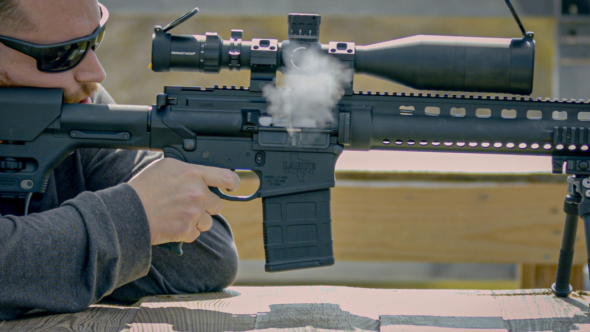



When measuring group size you must subtract the diameter of the bullet (.338) from the total outside width of the group. A two shot group touching would be 0.676 total width-0.338 bullet diameter reaching a whopping .338” group. It allows for center to center measurement of each bullet hole.